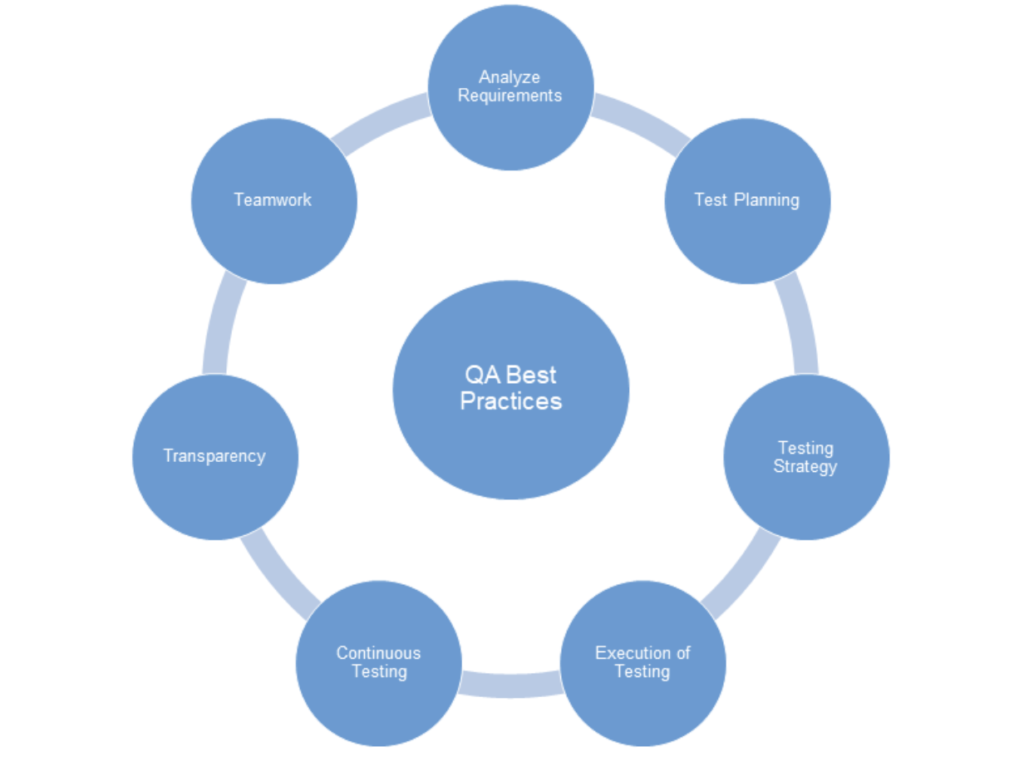
What is the Quality Assurance Process?
Quality Assurance is a methodical approach to ensure the highest level of product and service quality. A strong quality assurance team investigates the requirements for designing, developing, and manufacturing dependable products. It aims to boost customer confidence, corporate credibility, and the ability of a business to compete in a competitive climate.

It is crucial to have in place for software, website and app development, and should run concurrently with it rather than after it. Ideally, the QA process must be carried out in an Agile manner to analyze software functionality as soon as it is pushed to the repository. Let’s take a dive into the 7 stages of QA Best Practices with xDNA:
1. Analyzation of Requirements
Fixing a bug discovered during the testing stage is much more expensive than just eliminating them during the specifications design stage. To prevent this, QA specialists are involved in the analysis and definition of both functional and non-functional software requirements. Consistent, thorough, verifiable, and clearly indicated requirements must be provided to QA’s beforehand to aid in creating tests specific to the software being evaluated.
2. Test Planning
The information gathered during the requirements analysis step is utilized to plan the required tests. The software testing strategy, scope of testing, project budget, and deadlines are all included in the test plan. These specify the necessary types and degrees of testing, procedures and tools for issue tracking, as well as assign specific resources and duties to individual testers.
3. Design Testing Strategy
It is recommended that QA’s begin with exploratory testing to become well-acquainted with the software. This ultimately aids in the development of relevant test cases. The QA team then creates test cases and checklists that cover all of the technical specifications. Criteria, data, and the actions required to validate each functionality must all be included in each test case. Additionally, every test must include and consider an “expected” test result to compare with actual results.
This is also the point wherein the staging environment is prepared for execution. In terms of hardware, software, and network configurations, this environment should closely resemble the production environment. Other features such as databases and system settings should be closely replicated.
4. Test Execution & Bug Reports
Unit tests are performed by developers at the beginning of the testing process. The QA team then conducts tests at the API and UI levels. Manual testing is carried out in accordance with test cases that have been previously defined. All discovered bugs are then entered into a defect tracking system.
5. Test Early & Test Often
Early and frequent testing ultimately saves businesses a lot of time and money. The agile methodology strives to incorporate quality assurance at every level of the project’s development in order to discover problems at an early stage. The Quality Assurance Team tests and retests the product, with each new feature added, throughout each sprint. This allows them to ensure that the new features are implemented correctly and to quickly identify any issues that may arise.
6. Transparency is a Must
Transparency is beneficial to any development approach, but it is particularly important for Agile success. Testers must understand exactly what the product is supposed to perform, which features to test in each sprint, and what “excellent results” are. This clarity allows teams to work more effectively, test faster, and produce solutions on time.
After finding, submitting, and fixing defects, QA’s retest the functions to ensure nothing is missed out. Regression tests are also run to ensure that the new fixes have not broken any existing features. It should not be put off until the end of the development cycle, but rather, after each code commit. It must happen at the end of each sprint to allow problems to be spotted early.
7. Teamwork Produces Quality
Behind every high-quality product, is a team of professionals who work tirelessly to preserve the organization’s high-quality standards. Although each team on the project is responsible for quality, the QA team is in charge of the most important aspects of the project. They have a mastery of what the client expects from the system and can demonstrate the client’s satisfaction and approval when using it. Engineers are the super-sleuths who help the team provide high-quality products and assure client confidence, corporate credibility, and successful product delivery using the Agile QA methodology.
Main Takeaways
Quality assurance is critical in software development since it ensures that your product is developed efficiently and with the fewest possible defects and bugs. Without it, software development may be risky, with products eventually requiring complete rewrites. Having systems and processes in place during the production stage hugely benefits businesses by identifying and preventing the majority of issues as early as possible. So that any faults that do manage to slip through tend to be minor, easy to correct, and cost significantly less.
To ensure that your software products are able to compete in the rapidly changing software industry, maintaining a high level of quality and performance is key. Employing a high level of quality assurance ensures that the product’s quality and competitiveness are established even before it is distributed to customers, and confidently remains well-intact with each subsequent update rollout.

